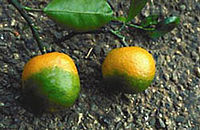- Huanglongbing
-
 Huanglongbing on mandarin oranges
Huanglongbing on mandarin oranges
Huanglongbing (from Chinese 黃龍病 huáng lóng bìng, literally Yellow Dragon Disease), also known as HLB,[1] citrus vein phloem degeneration (CVPD), citrus greening disease, yellow shoot disease, leaf mottle yellows in the Philippines, libukin in Taiwan and citrus dieback in India, is probably the worst disease of citrus caused by a vectored pathogen. The causative agents are motile bacteria, Candidatus Liberibacter spp. Transmission is by the Asian citrus psyllid (Sternorrhyncha: Psyllidae), Diaphorina citri or, in Africa, by Trioza erytreae, the African citrus psyllid, also known as the 2-spotted citrus psyllid. The disease was first described in 1929 and first reported in China in 1943. Likubin has seriously affected Taiwan since 1951. The African variation was first reported in 1947 in South Africa, where it is still widespread.
The causative agents are fastidious phloem-restricted, gram-negative bacteria in the gracilicutes clade. The Asian form, L. asiaticus is heat tolerant. This means the greening symptoms can develop at temperatures of up to 35°C. The African form, L. africanum, is heat sensitive and in its case, symptoms only develop when the temperature is in the range 20-25°C.[2] The bacteria are transmitted by the psyllid vectors and also by graft transmission.[3] Although Trioza erytreae is the natural vector of African citrus greening and Diaphorina citri is the natural vector of Asian citrus greening, either psyllid can in fact transmit either of the greening agents under experimental conditions.[4]
Distribution of CVPD is primarily in tropical and subtropical Asia. It has been reported in all citrus-growing regions in Asia except Japan. The disease has affected crops in China, Taiwan, India, Sri Lanka, Malaysia, Indonesia, Myanmar, Sri Lanka, the Philippines, Pakistan, Thailand, the Ryukyu Islands, Nepal, Saudi Arabia, and Afghanistan. Areas outside Asia have also reported the disease: Réunion, Mauritius, Brazil, and Florida in the U.S. since 1998, and in several municipalities in Mexico since 2009[5][6][7][8][9]
This disease is distinguished by the common symptoms of yellowing of the veins and adjacent tissues; followed by yellowing or mottling of the entire leaf; followed by premature defoliation, dieback of twigs, decay of feeder rootlets and lateral roots, and decline in vigor; and followed by, ultimately, the death of the entire plant. Affected trees have stunted growth, bear multiple off-season flowers (most of which fall off), and produce small, irregularly-shaped fruit with a thick, pale peel that remains green at the bottom. Fruit from these trees tastes bitter.[1]
There is no cure for Huanglongbing and efforts to control the disease have been slow because infected citrus plants are difficult to maintain, regenerate, and study. Researchers at the Agricultural Research Service have used Huanglongbing-infected lemon trees to infect periwinkle plants in an effort to study the disease. Periwinkle plants are easily infected with the disease and respond well when experimentally treated with antibiotics. Researchers are testing the effect of penicillin G sodium and biocide 2,2-dibromo-3-nitrilopropionamide as potential treatments for infected citrus plants based on the positive results that were observed when applied to infected periwinkle. [2]
External links
- Asian citrus psyllid on the UF / IFAS Featured Creatures Web site
- Species Profile - Citrus Greening and Species Profile - Asian Citrus Psyllid, National Invasive Species Information Center, National Agricultural Library. Lists general information and resources for citrus greening and the Asian citrus psyllid.
- CISR: Huanglongbing/Citrus Greening Center for Invasive Species Research page on Huanglongbing and Citrus Greening
References
- ^ "The Disease: Huanglongbing (HLB)". Citrus Research Board. http://www.californiacitrusthreat.org/huanglongbing-citrus-greening.php. Retrieved 29 November 2010.
- ^ Garnier, M., S. Jagoueix-Eveillard, P. R. Cronje, G. F. LeRoux, and J. M. Bové. 2000. Genomic characterization of a Liberibacter present in an ornamental rutaceous tree, Calodendrum capense, in the Western Cape Province of South Africa. Proposal of 'Candidatus Liberibacter africanus subsp. capensis.' International Journal of Systematic and Evolutionary Microbiology 50: 2119-2125.
- ^ Lin, K. H. 1956. Observation on yellow shoot on citrus. Etiological studies of yellow shoot on Citrus. Acta Phytopathological Sinica 2:1-42.
- ^ Lallemand, J., A. Fos, and J. M. Bové. 1986. Transmission de la bacterie associé à la forme africaine de la maladie du “greening” par le psylle asiatique Diaphorina citri Kuwayama. Fruits 41: 341-343.
- ^ "Detection of Huanglongbing (Candidatus Liberibacter asiaticus) in the municipality of Tizimin, Yucatan, Mexico". North American Plant Protection Organization's Phytosanitary Alert System. http://www.pestalert.org/oprDetail.cfm?oprID=384. Retrieved 2010-10-02.
- ^ "Update on the detection of Huanglongbing (Candidatus Liberibacter asiaticus) in backyard trees in the States of Yucatan and Quintana Roo, Mexico". North American Plant Protection Organization's Phytosanitary Alert System. http://www.pestalert.org/oprDetail.cfm?oprID=401. Retrieved 2010-10-02.
- ^ "Update on the detection of Huanglongbing (Candidatus Liberibacter asiaticus) in backyard trees in Mexico". North American Plant Protection Organization's Phytosanitary Alert System. http://www.pestalert.org/oprDetail.cfm?oprID=410. Retrieved 2010-10-02.
- ^ "Detection of Huanglongbing (Candidatus Liberibacter asiaticus) in the Municipality of Calakmul, Campeche, Mexico". North American Plant Protection Organization's Phytosanitary Alert System. http://www.pestalert.org/oprDetail.cfm?oprID=423. Retrieved 2010-10-02.
- ^ "Detection of Huanglongbing (Candidatus Liberibacter asiaticus) in the Municipalities of Mazatlan and Escuinapa, Sinaloa, Mexico". North American Plant Protection Organization's Phytosanitary Alert System. http://www.pestalert.org/oprDetail.cfm?oprID=448. Retrieved 2010-10-02.
Categories:- Tree diseases
- Fruit tree diseases
- Plant pathogens and diseases
- Citrus diseases
Wikimedia Foundation. 2010.
